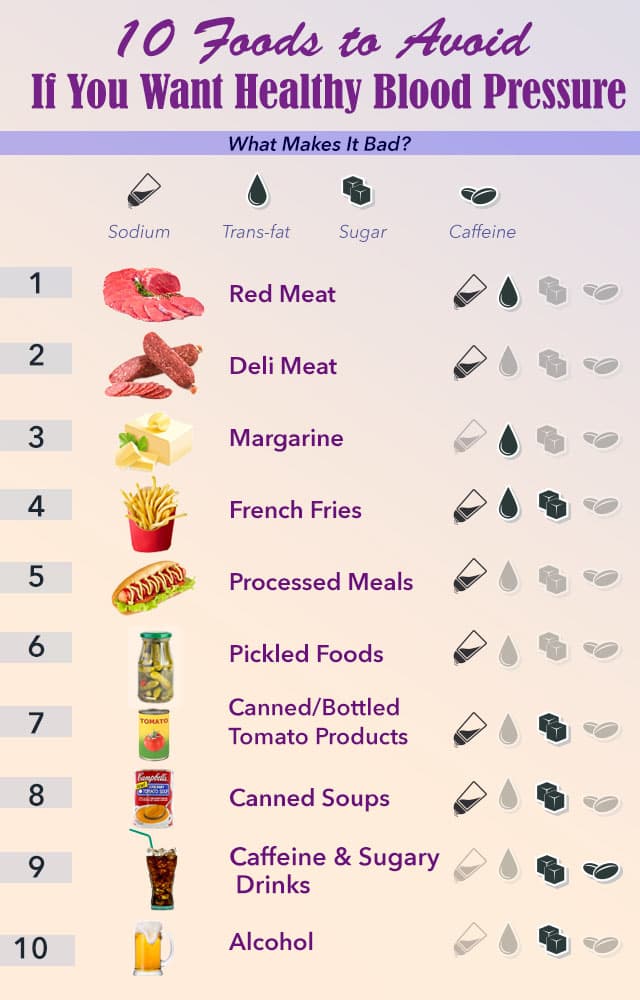Maintaining healthy blood pressure is an essential part of achieving total wellness.
As with any area of health, there’s a lot you can do to keep your blood pressure numbers in a healthy range. Exercise, diet and stress management all come into play.
The word “diet” contains several layers, including what to eat, what not to eat, when to eat, when to stop eating, what to drink, what not to drink and so on.
While plenty has been written about foods that are good for you, there’s a lot we need to keep in mind when stocking the kitchen.
Reading food and drink labels is essential.
Sodium, sugar and trans fats can cause a spike in blood pressure levels and overall damage to your body.
A healthy diet allows for 2,400 milligrams of sodium per day, but trans fats aren’t necessary, and the main accepted source of sugar is fruit.
There are many food and drink products that should be avoided in order to maintain healthy blood pressure. Read on to learn about the top ten.
1Red Meat
 Not all red meat is bad. Eaten in moderation, some can benefit your muscles, bones and joints. Regardless, fatty red meat should be avoided due to the high content of trans fats, which wreak havoc on the heart and blood vessels. These meats also contain higher amounts of sodium. If you’re eating meat for protein, try a leaner option like chicken.
Not all red meat is bad. Eaten in moderation, some can benefit your muscles, bones and joints. Regardless, fatty red meat should be avoided due to the high content of trans fats, which wreak havoc on the heart and blood vessels. These meats also contain higher amounts of sodium. If you’re eating meat for protein, try a leaner option like chicken.
2Deli Meat
 Speaking of chicken, not all are sold with equal quality. Chicken, turkey, ham and other meats that come from packages are a sodium trap. They are oftentimes seasoned and preserved with salt and result in way too much sodium, not to mention the sodium added when making a sandwich with bread, cheese and condiments.
Speaking of chicken, not all are sold with equal quality. Chicken, turkey, ham and other meats that come from packages are a sodium trap. They are oftentimes seasoned and preserved with salt and result in way too much sodium, not to mention the sodium added when making a sandwich with bread, cheese and condiments.
3Margarine
 Like red meat, margarine comes with exceptions. The main culprit in this dairy product is trans fat. Some margarine products come with 2 or more grams of trans fat per tablespoon. When you think about how much margarine people actually put on their food or in recipes, that’s a lot of trans fat. Look for margarine without trans fat (they do exist!) or find a substitute.
Like red meat, margarine comes with exceptions. The main culprit in this dairy product is trans fat. Some margarine products come with 2 or more grams of trans fat per tablespoon. When you think about how much margarine people actually put on their food or in recipes, that’s a lot of trans fat. Look for margarine without trans fat (they do exist!) or find a substitute.
4French Fries
 French fries are the most popular side ordered in restaurants. Unfortunately, they’re not the best option. Restaurants oftentimes cook French fries in cheap, unhealthy oils or fats, and they’re seasoned with salt. Some fries also have a coating of sugar on them. Your best bet is to order a salad, cooked vegetable or fruit when eating out, and leave the fries for at home.
French fries are the most popular side ordered in restaurants. Unfortunately, they’re not the best option. Restaurants oftentimes cook French fries in cheap, unhealthy oils or fats, and they’re seasoned with salt. Some fries also have a coating of sugar on them. Your best bet is to order a salad, cooked vegetable or fruit when eating out, and leave the fries for at home.
5Processed Meals
 Popping an already prepared meal into the oven or microwave may sound convenient, but it may come at the cost of your health. Whether considered “healthy” recipes or not, these meals are full of sodium and other preservatives. Frozen pizza, for example, can have 1,000 to 2,500 milligrams of sodium per serving. Instead, put aside a little extra time to prepare food. Your blood pressure and many other areas of health will thank you for it.
Popping an already prepared meal into the oven or microwave may sound convenient, but it may come at the cost of your health. Whether considered “healthy” recipes or not, these meals are full of sodium and other preservatives. Frozen pizza, for example, can have 1,000 to 2,500 milligrams of sodium per serving. Instead, put aside a little extra time to prepare food. Your blood pressure and many other areas of health will thank you for it.
6Pickled Foods
 How could pickles, sauerkraut and other pickled foods possibly be bad? Again, sodium. Salt is added in excess to preserve and flavor pickled foods. The longer it sits the more sodium it soaks up. One pickle spear contains up to 300 milligrams of sodium. If you can’t imagine giving up pickles, read your labels and choose a low sodium option.
How could pickles, sauerkraut and other pickled foods possibly be bad? Again, sodium. Salt is added in excess to preserve and flavor pickled foods. The longer it sits the more sodium it soaks up. One pickle spear contains up to 300 milligrams of sodium. If you can’t imagine giving up pickles, read your labels and choose a low sodium option.
7Canned/Bottled Tomato Products
 Tomatoes are delicious and come with many health benefits, but putting them in a can or bottle automatically puts them on the no-go list. Tomato sauces, pasta sauces and juices all contain high levels of sodium. A serving of these products contains hundreds of milligrams of sodium, not to mention sugar and other preservatives. Opt for low sodium if you’re going to use these products.
Tomatoes are delicious and come with many health benefits, but putting them in a can or bottle automatically puts them on the no-go list. Tomato sauces, pasta sauces and juices all contain high levels of sodium. A serving of these products contains hundreds of milligrams of sodium, not to mention sugar and other preservatives. Opt for low sodium if you’re going to use these products.
8Canned Soups
 It will come as no surprise at this point that canned soups also contain high levels of sodium, as well as sugar and other preservatives. Some soups have more than 2,000 milligrams of sodium per can! The best way to avoid this sodium trap is to make your own soup. If that isn’t doable, look for low sodium options. Again, read your labels.
It will come as no surprise at this point that canned soups also contain high levels of sodium, as well as sugar and other preservatives. Some soups have more than 2,000 milligrams of sodium per can! The best way to avoid this sodium trap is to make your own soup. If that isn’t doable, look for low sodium options. Again, read your labels.
9Caffeine & Sugary Drinks
 While coffee comes with many health benefits, it can cause a temporary rise in blood pressure. Likewise, the caffeine and sugar in soft drinks and other beverages can spike blood pressure levels. This can have a negative impact on people with blood pressure problems. Try cutting out sugary drinks, limiting your coffee intake and opting for water or caffeine free teas instead.
While coffee comes with many health benefits, it can cause a temporary rise in blood pressure. Likewise, the caffeine and sugar in soft drinks and other beverages can spike blood pressure levels. This can have a negative impact on people with blood pressure problems. Try cutting out sugary drinks, limiting your coffee intake and opting for water or caffeine free teas instead.
10Alcohol
 Some studies suggest that a small amount of alcohol can actually lower blood pressure, but drinking more can cause it to spike. It can also contribute to hypertension and damage to blood vessel walls. Alcohol is generally created by fermenting sugary foods, and we know by now that too much sugar raises blood pressure. If you’re going to drink, keep it light and moderate.
Some studies suggest that a small amount of alcohol can actually lower blood pressure, but drinking more can cause it to spike. It can also contribute to hypertension and damage to blood vessel walls. Alcohol is generally created by fermenting sugary foods, and we know by now that too much sugar raises blood pressure. If you’re going to drink, keep it light and moderate.
Did any food on this list surprise you?
What foods do you avoid to maintain a healthy blood pressure?
Sources:




